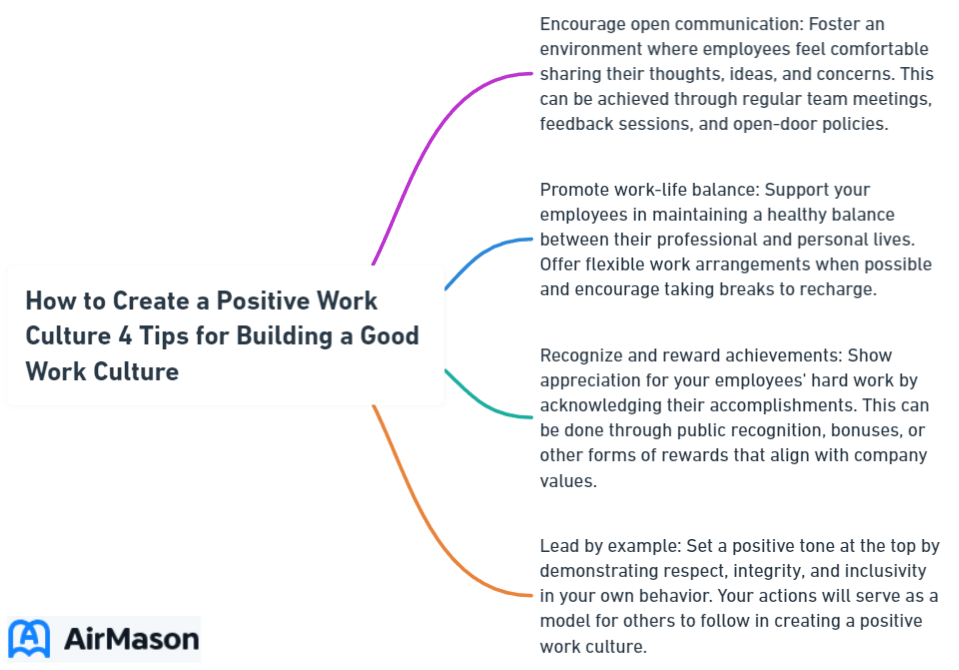
Picture this: you wake up every morning excited to go to work, knowing you’re part of a supportive and collaborative team, sharing common values and goals. Sounds like a dream, right? Well, this dream can become a reality when companies focus on creating a positive work culture. By prioritizing employee well-being, fostering open communication, and embracing diversity, organizations can build a thriving environment where everyone feels valued and motivated to succeed.
In this blog post, we’ll dive into the essential components of a good work culture and explore practical strategies to help you create a positive and fulfilling workplace. So, let’s embark on this journey together and learn how to foster a work culture that not only attracts top talent but also nurtures growth, innovation, and success.
Key Takeaways
- Create a positive work culture to foster growth and success by embodying core values, effective leadership and employee engagement.
- Attract top talent with higher retention, increased satisfaction & improved productivity through open communication, diversity & inclusivity, development opportunities and enjoyable atmosphere.
- Overcome common challenges such as resistance to change by learning from inspiring examples of successful companies like Google or Microsoft.
Understanding Good Work Culture
Understanding the key elements is a prerequisite to creating a positive work culture. A strong work culture is built on a foundation of a company’s core values, effective leadership, and engaged employees. These factors contribute to a distinct corporate culture that sets the tone for an organization’s success.
A good work culture is one where employees feel valued and supported, and where the company’s values are clearly communicated and lived by everyone. It’s a place where employees prioritize work-life balance and are encouraged to grow professionally and personally. By contrast, a toxic work environment breeds stress, disengagement, and high turnover. Next, we’ll explore the pivotal elements of a healthy work culture: core values, leadership, and employee engagement.

The role of core values
Company culture is deeply rooted in the company’s core values. These values serve as a guiding light, shaping the organization’s culture and providing a clear sense of purpose and direction. Establishing and adhering to core values is crucial for creating a strong foundation for a positive work environment. When everyone in the company understands and lives by these values, it fosters a sense of unity and shared goals.
Creating a concise list that truly mirrors your company’s mission and long-term objectives is imperative for accurately representing your company’s core values. Hiring for culture adds can also help nurture a positive and productive work environment, ultimately leading to greater success for the company and its team members.
The impact of leadership

The role leaders play in shaping a positive work culture is crucial. Their actions, priorities, and the way they embody the company’s core values have a profound impact on the workplace culture. By setting the right example and demonstrating desired behaviors, leaders inspire engaged employees and pave the way for a positive work environment.
Moreover, having cultural representation among leadership teams is fundamental. It ensures that the employee experience aligns with the company’s beliefs and values at every stage, contributing to a healthy work culture. Compassionate leaders who genuinely care about their employees can further enhance this feeling by implementing employee recognition programs that show appreciation and reward hard work.
The significance of employee engagement
A thriving work culture essentially thrives on employee engagement. Engaged employees are more committed, productive, and loyal to the company. Fostering employee engagement is essential in building a distinct corporate culture and driving organizational success. Creating a work environment that everyone can take pride in is possible by valuing your employees’ feedback and utilizing it to its fullest potential.
Recognizing and praising employees can make a significant difference in their enthusiasm and motivation. When employees feel their hard work is being noticed and acknowledged, they are more likely to go the extra mile to exceed expectations and deliver outstanding results. Implementing an employee recognition program can further enhance this positive impact.
Additionally, promoting workplace wellness and allowing employees to take regular breaks can lead to increased productivity and motivation.
An Organization’s Culture
An organization’s culture refers to the collective values, beliefs, and behaviors that shape its identity and guide the conduct of its members. It encompasses the unwritten norms that influence how individuals interact, make decisions, and pursue the organization’s objectives. This culture is not static; rather, it evolves over time in response to various internal and external factors. A healthy and well-defined organizational culture fosters a sense of belonging and purpose among employees, aligning their efforts towards common goals. Conversely, a dysfunctional or neglected culture can lead to discord, hinder productivity, and impede the organization’s progress. Therefore, understanding, nurturing, and, when necessary, reshaping an organization’s culture is paramount for its success and longevity.
Benefits of Good Work Culture

Cultivating a good work culture comes with a host of benefits that can greatly impact your organization. A positive work culture attracts and retains top talent, enhances employee well-being, and bolsters the company’s reputation. By fostering a supportive and inspiring environment, companies can improve employee morale, reduce absenteeism, and drive positive change.
Next, we’ll examine some specific benefits of a good work culture, including attracting and retaining top talent, improving employee well-being, and enhancing the company’s reputation.
Attracting and retaining top talent
A good work culture is a magnet for top talent. When employees feel valued and supported, they are more likely to stay with the organization, leading to improved performance and reduced staff turnover. Companies with a positive work culture tend to have:
- Higher employee retention rates
- Increased employee satisfaction
- Improved productivity
- Enhanced teamwork and collaboration
- Better employee morale
Individuals are drawn to environments where they can grow and thrive, and a positive work culture, as well as positive cultures in general, provide the foundation for that.
Creating a supportive and inspiring company culture that mirrors their core values from the outset is crucial for organizations looking to retain valuable employees. By rewarding and acknowledging employees’ hard work and offering flexible hours that cater to their needs, you can elevate their experience and ensure they remain committed to your organization.
Enhancing employee well-being
A positive work culture can work wonders for employee well-being. When employees feel supported and valued, they experience:
- Reduced stress and anxiety
- Improved mental and physical health
- Positive emotions
- Increased work engagement
- Healthy habits that prioritize mental health
Such a work environment promotes overall well-being and productivity, both inside and outside of work, making it an ideal place to work.
Fostering a positive work culture can also enable companies to boost job satisfaction and improve work performance. Employees who feel appreciated and respected in their work environment are more likely to be productive, focused, and committed to achieving their goals. In turn, this boosts the overall success of the organization.
Boosting company reputation
A good work culture not only benefits employees but also enhances the company’s image and reputation. When an organization is known for its positive work environment, it becomes more appealing to potential employees, customers, and investors. A strong reputation can also help attract top talent and drive business success.
Companies like:
- Zappos
- Capital One
- Publix Super Markets
are renowned for their excellent work cultures, which have helped build their stellar reputations. By learning from their experiences and adopting their best practices, other organizations can similarly cultivate a positive work culture that boosts their reputation and success.
Four Tips to Build a Good Work Culture

Having explored the essential components and benefits of a good work culture, we’ll now move on to some practical strategies for fostering a positive work environment. Here are some ways to achieve this:
- Encourage open communication
- Celebrate diversity and inclusivity
- Invest in employee development
- Foster a supportive and enjoyable atmosphere
By implementing these strategies, you can make sure to create a work culture where everyone thrives.
We’ll further examine each of these suggestions and understand how they can assist in transforming your work culture into a thriving and inspiring environment.
Encourage open communication and transparency
Building trust and nurturing a positive work culture relies heavily on promoting open communication and transparency. When employees feel comfortable sharing their ideas, concerns, and feedback, it creates an environment where collaboration and innovation can flourish. Clear communication also helps establish mutual respect and understanding among team members.
To foster open communication, consider implementing feedback boxes, team messaging platforms, or regular meetings where employees can voice their opinions and ask questions. Encouraging personal conversations and creating a safe space for employees to express their thoughts can further enhance open communication and build a strong work culture.
Foster diversity and inclusivity
Creating a positive work culture necessitates the embracing of diversity and inclusivity in the workplace. By welcoming individuals from all backgrounds and celebrating their differences, you can create an inclusive work environment that fosters creativity, innovation, and collaboration.
Diversity and inclusivity also contribute to a richer and more dynamic workplace culture, where everyone can learn from each other’s unique perspectives and experiences. By promoting diversity initiatives and creating an inclusive atmosphere, your organization can reap the benefits of a diverse and engaged workforce.
Prioritize employee development and growth
To create a positive work culture and propel organizational success, investing in employee development and growth is key. By offering training programs, mentorship opportunities, and resources for professional development, you demonstrate your commitment to your employees’ success and well-being.
Supporting employee growth not only benefits the individual but also contributes to the overall success of the organization. As employees develop new skills and advance in their careers, they become more engaged, productive, and committed to the company’s goals and values.
Create a supportive and fun atmosphere
A fun and supportive work environment plays a significant role in reducing stress, promoting creativity, and fostering a good work culture. By organizing team-building activities, celebrating achievements, and encouraging a lighthearted atmosphere, you can create a workplace where employees feel motivated and inspired.
A positive work environment also promotes strong relationships among team members, leading to better collaboration and a stronger sense of belonging. By nurturing a supportive and fun atmosphere, you can pave the way for a thriving work culture that benefits both employees and the organization.
Building Culture at Work
Building a strong and positive culture at work is paramount for fostering a productive and engaging environment. When focusing on building culture at work, it’s essential to emphasize shared values and a sense of community among employees. This involves not only creating policies and guidelines but also embodying these principles in everyday interactions. Encouraging open communication, recognizing achievements, and providing opportunities for professional development are key components of a thriving work culture. Moreover, leaders play a crucial role in setting the tone and exemplifying the desired behaviors, which, in turn, trickle down through the organization. By consistently investing in the development of a healthy work culture, companies can attract and retain top talent while simultaneously enhancing overall performance and satisfaction levels among their employees.
Real-Life Examples of Good Work Culture

To further inspire you in your quest to build a good work culture, let’s look at some real-life examples of companies that have successfully fostered positive work environments. Companies like:
- Adobe
- Chevron
are all known for their thriving work cultures.
What sets these companies apart is their commitment to their core values, their focus on creative problem-solving, and their mission-driven culture. By learning from their experiences and adopting their best practices, you too can create a positive work culture that drives innovation, growth, and success.
Common Challenges and Solutions in Building a Good Work Culture

Challenges are inevitable on the path to building a good work culture. Organizations often face common obstacles, such as overcoming resistance to change, balancing flexibility and structure, and nurturing a positive culture in remote and hybrid work settings. By addressing these issues head-on and adopting effective strategies, you can overcome these challenges and create a thriving work culture.
We’ll now discuss solutions to these prevalent challenges, with an emphasis on:
- Strategies to overcome resistance to change
- Striking a balance between flexibility and structure
- Sustaining a positive work culture in remote and hybrid work settings.
Overcoming resistance to change
Resistance to change can hinder the growth of a positive work culture. To overcome this obstacle, organizations should:
- Foster a culture of adaptability and continuous improvement
- Embrace change and encourage employees to view it as an opportunity for growth
- Build a strong work culture that thrives in the face of challenges
Some inspiring examples of companies that have successfully navigated resistance to change include:
- Microsoft
- Amazon
- Toyota
- Netflix
- Starbucks
- The Walt Disney Company
- LEGO
By learning from their experiences and embracing change as a catalyst for success, your organization can create a resilient and adaptable work culture.
Balancing flexibility and structure
Creating a good work culture that bolsters both employee autonomy and organizational goals necessitates striking the right balance between flexibility and structure. Companies that offer too much flexibility may struggle with inconsistency and unfairness, while those with too much structure may stifle creativity and limit employee growth.
To find the right balance, organizations should avoid inflexible schedules, enable employees to create their own flexibility, and equip managers to support flexible work arrangements. By striking a balance based on the nature of the business, companies can create a work culture that fosters both employee satisfaction and organizational success.
Nurturing a positive culture in remote and hybrid work settings
Maintaining a good work culture in remote and hybrid work environments can be challenging, but it’s not impossible. By focusing on effective communication, virtual team-building activities, and supporting work-life balance, organizations can nurture a positive work culture that transcends physical boundaries.
Companies should also prioritize onboarding and training for remote employees, schedule regular check-ins, and promote team collaboration to ensure everyone feels connected and included. By adopting these strategies, organizations can create a positive and successful remote work culture that supports employee well-being and productivity.
The Importance of Nurturing a Positive Company’s Organizational Culture
A company’s organizational culture plays a pivotal role in shaping its identity and influencing the behavior of its employees. It encompasses the values, beliefs, and norms that guide the way individuals interact and work together within the organization. Fostering a positive company’s organizational culture not only enhances employee satisfaction and engagement but also contributes to higher productivity and innovation. When employees feel aligned with the company’s values and objectives, they are more likely to be motivated and dedicated to achieving shared goals. Moreover, a strong organizational culture can attract top talent, as prospective employees are increasingly valuing workplace environments that prioritize a healthy work-life balance and a sense of belonging. Therefore, investing in and actively nurturing a positive company’s organizational culture is not just a human resources initiative, but a strategic imperative for long-term success and sustainability.
Summary
In conclusion, building a good work culture is essential for the success of any organization. By understanding the key components of a positive work environment, such as core values, leadership, and employee engagement, and implementing practical strategies like open communication, diversity and inclusivity, employee development, and a supportive atmosphere, you can create a thriving work culture that benefits both employees and the organization.
Remember that nurturing a good work culture is an ongoing journey that requires continuous effort and adaptability. By learning from successful companies and addressing common challenges, you can pave the way for a work culture that fosters growth, innovation, and success. So, let’s get started on creating a work culture that makes every day a great day at the office!
Frequently Asked Questions
What is strong work culture?
Based on the provided text, it appears to be a single paragraph. To improve readability, I will split it into two paragraphs: Paragraph 1: Strong work culture encourages open communication, builds unified purpose, and fosters collaboration. It sets the tone for a positive work environment, making employees feel heard and respected. Paragraph 2:
How do you have a good culture at work?
Creating a positive work culture starts with establishing strong ethics and values, promoting inclusion, fostering open communication and providing an inviting workplace. Additionally, focus on setting clear objectives, aligning with long-term goals, encouraging diversity and transparency, and showing your employees they are valued.
What are the key components of a good work culture?
Strong core values, inspiring leadership and engaged employees are the key components of a good work culture, creating an environment of mutual trust, respect and success.
How can a good work culture benefit employees and organizations?
A good work culture can be a major advantage for both employees and organizations, as it attracts and retains top talent, enhances employee well-being, and boosts the company’s reputation. This all leads to a more productive, creative, and successful workplace.
What are some practical strategies for building a positive work culture?
Foster an atmosphere of open communication, celebrate diversity and inclusivity, invest in employee development, and create a supportive environment to build a positive work culture.